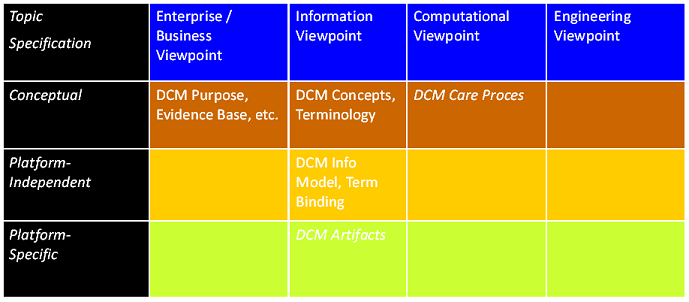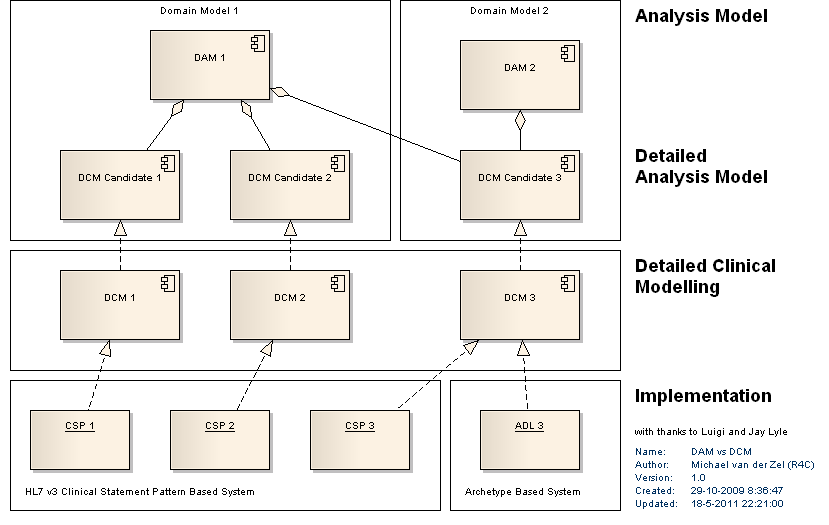DAM vs DCM vs SAIF
return to: Patient Care
further to: Detailed Clinical Models
further to: Detailed Clinical Model instance construction
further to: Detailed Clinical Model guidelines for creation
DAM vs DCM vs SAIF
There are several questions asked within the HL7 community about the relationship between a Domain Analysis Model (DAM) and a Detailed Clinical Model (DCM)and how this fits into the Serfices-Aware Inteoperability Framework (SAIF) (numbers refer to the TSC list of questions of December 2009):
1. Are the DCMs intended to represent a more-detailed version of a DAM, or does it represent a detailed message model?
- DCMs may represent a Conceptual/Domain Analysis model specific to the Business Viewpoint in RM-ODP as specified by SAIF. DCM is focused on the business/clinical view-points and is intended to identify the clinically-relevant abstractions. Thus it fit into the Business-Centric Domain Analysis Model or into the Business Viewpoint of a SAIF-conformant Conceptual Model. As the differences between a DAM and Computation-Independent Model (CIM) (aka SAIF/ Conceptual Model) are further harmonized throught the efforts of the EAIP project, the confusion will be completely resolved.
- DCMs and DAMs are both UML models representing a conceptual view of specific interoperability. Therefore DCMs can be published as DAMs.
- DCMs do not represent a detailed message model. Patient Care has developed such clinical R-MIMs in the past (see the topic of care structures in the ballot). But XML experts gave feedback that this approach would lead to exploding permutations of the XML messages. Patient Care has been looking for alternative approaches since 2005. One is to have a R-MIM for typical clinical information, such as vital signs and assessment scales. For each an R-MIM is created and balloted that allow to specify the data elements, codes, data types and value(sets). In the assessment scale topic the Hl7 R-MIM, for use in multiple HL7 messages following clinical statement pattern, is presented. Alongside with proper coding for each scale element. Thus to implement clinical details, the use of element identification, coding and specification together with the R-MIM is one solution.
The second option would be to use HL7 templates. However, these are still non-existent as part of formal balloted material.
Detailed Clinical Models (DCM) are small items of clinical, preventive and care information that are well defined and for which knowledge, data definition, vocabulary binding, and information model for use in information and communication technology are standardized and reusable over domains, purposes, standards and implementations (adapted from Brisbane workshop, 2007).
This preliminary definition might be updated in the next couple of months, heading to the ISO CD due end of February.
Q16. How do the DCM’s fit with the SAIF methodology? and Q 19. How would a DCM be classified or used within the SAIF – where in the SAIF matrix would one find a DCM?
- DCM is covering the business part and the Information Model, but all conceptual
- From the DCM Information Model Platform Independent and Platform Bound artifacts can be generated (MDA)
Michael In the following matrix the DCM artifacts are positioned in the SAIF Matrix. The vertical columns are the ISO ODP-RM viewpoints and the horizontal columns are MDA viewpoints. ODP-RM is The Open Group Reference Model for Enterprise Architecture (EA). Each view addresses a different aspect of EA. The Enterprise vp is about high-level business views, e.g. scope and vision. The information vp is about the information, e.g. the business classes. The Computational vp is about processing the Information. And finally the Engineering vp and actually Technology vp are about the realisation in IT, e.g. Java or .Net and such. Then MDA (Model Driven Architecture/Development) are about generating software from models. The ultimate IT solution will generate all software from models. In the real world we know that most transitions are done by hand. The CIM (Conceptual Information Model) is the conceptual model, then we have the PIM (Platform Independent Model, Logical) and finally the most concrete (software and configuration files that can actually run), the PSM (Platform Specific Model, Physical).
23. Is a DCM a reusable fragment of a DAM?
Yes it is. This means that a DCM that specifies a pain scale or a blood pressure can be used in hundreds of DAMs and also in hundreds of EHR Functional Profiles.
However, to be implementable in HL7 DCM need to be transformed either in an R-MIM plus variable table format, preferably Clinical Statement conformant, or into HL7 templates. Similarly, a DCM can be transformed into a CEN/ISO 13606 archetype or an OpenEHR archetype.
DAM vs DCM in diagram format
This diagram illustrates the relationship between a Domain Analysis Model or DAM, as currently developed in the HL7 space and the Detailed Clinical Model or DCM. Both a DAM and a DCM are not created using HL7 methodology, but more generic health informatics modeling approaches. A DAM usually covers a whole clinical domain, for instance TB care, Cardiology, Emergency and so on. At a particular level a DAM remains generic, where detailed clinical data are expected to be expressed in another format. DCM steps in that space: the nitty gritty details. See the examples how detailed level we are working on with a DCM. So a DCM can be seen as a leaf node of a DAM. In addition that would apply also for the leaf node specification in the EHR profile.
When a DCM is available as an abstract specification of a clinical concept, its data-elements and specification and the relationships, it can be transformed into any kind of technological formalism. We do have several examples in the Care Provision Care Structures Topic where these reside as a R-MIM roll out of Care Statement / Clinical Statement. In the Assessment Scale Topic of Care Provision, several tables with data - element specifications and code bindings are illustrated, based on the work of Frank Oemig in Germany.
Finally, as illustrated in the picture DCM can be transformed into HL7 v3 templates as soon as these start becoming existent. Another formalism currently used for implementation of a DCM is the CEN/ISO 13606-2 archetype (as in ADL 1.2), or an OpenEHR archetype (as in ADL 1.4). Work is ongoing on the appropriate transformations.
The picture below is a recent adjustment made by Jay Lyle while working on the project Detailed Clinical Model for Medical Devices. The picture was presented during the HL7 meeting in Boston in October 2010.

